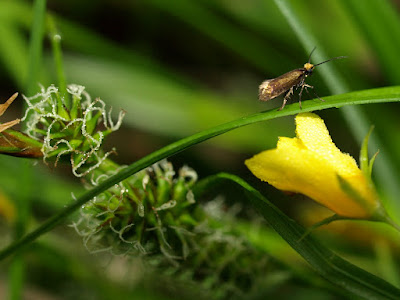
This landed on my clipboard when I was out surveying the other day near Stonegate. Bits of leaf tissue, bud scales, disintegrating catkins and frass form a kind of dry rain that constantly falls from the canopy onto the woodland surveyor who must sweep his or her notes often to remove detritus. This rain also includes many living organisms, especially at this time of year - lepidopteran larvae parachute down on spun silk. At first I took this for a bit of desiccated leaf tissue. But when it resisted efforts to be shaken or swept off, I realised this was only half right. Reminiscent of a 6mm long cigar, it is the mobile home of a tiny moth caterpillar (a case moth,
Coleophora sp. probably
serratella), constructed from a piece of rolled tree leaf (the food plant) and bound together (I suppose with silk). It makes two of these in its lifetime and each is architecturally distinct. This one is its second and will form the pupal case when the caterpillar has stopped feeding. The larva will soon attach itself and the case to a sunlit leaf and the adult moth will metamorphose inside. It may even have been attempting to pupate on my clipboard.
 Nemophora degeerella
Nemophora degeerella (left)
A beautiful longhorn moth, I’m surprised it has no English name. For scale, it is standing on the serration at the margin of a nettle leaf. This is a male, with antennae four or five times the length of its forewing. Groups of them fly up and down in vertical columns sometimes in small gaps in the canopy (books say they fly at dusk but I often see them doing this in the middle of the day). When they do this above a sunspot on the woodland flooor, the long antennae catch and reflect the light and are very striking. It is said that this behaviour attracts females.

Silver Ground Carpet -
Xanthorhoe montanata (right) – ubiquitous according to Townsend and Waring. Day-flying and apparently very common in the woods of the High
Weald.
 Anthophila fabriciana
Anthophila fabriciana – Nettle-tap (left), on its food plant, stinging nettle, in a secondary wood full of that plant. Thanks to David Burrows for identifying this.
 Poplar Hawkmoth - Laothoe populi (above); Eyed Hawkmoth - Smerinthus ocellata (top - showing eyespots and mammal like 'face', & below - eyespots concealed)
Poplar Hawkmoth - Laothoe populi (above); Eyed Hawkmoth - Smerinthus ocellata (top - showing eyespots and mammal like 'face', & below - eyespots concealed)

























